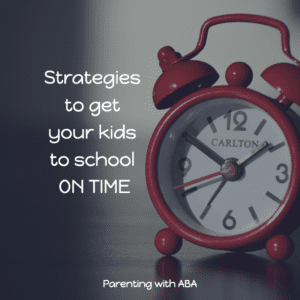This article by Leanne Page, M.Ed., BCBA was originally published at bSci21.org.
“Dear Behavior BFF, I have the hardest time getting my kids to school on time in the mornings. The whole morning will go pretty okay until it’s time to put on shoes, coats, and backpacks and get out the door. My sons don’t argue about brushing teeth, getting dressed, breakfast, whatever- just that last step. What gives?!”
Mornings are hard. I feel you. Parent solidarity! There’s got to be something you can do to make them easier, right? Well, you’ve come to the right place. If you are going to try anything, why not try something that is evidence-based? Why not try the science of behavior? Good call.
In order to ease these morning routine stressors, let’s look at something called behavioral momentum. Behavioral momentum has been defined as the use of a series of high-probability requests to increase compliance with lower-probability requests (Ray, Skinner & Watson, 1999).

A high probability request means something that your child does with some regularity. There is a high probability that your child will complete it independently and quickly. These are the easy tasks you listed above- the things they don’t argue about. A low probability request is that task that there is a low probability of your kiddo completing easily the first time they are asked. These are the things that feel more like pulling teeth than simple parenting.
Enter behavioral momentum. Think about momentum itself. Think about gaining steam with forward movement. We want to create some momentum with a few successful tasks in a row before presenting the dreaded task of putting your coat on (or whatever it may be for each child).
The easy tasks or demands should be just that- easy. It might be something as simple as “give me a high five”. That is still a demand that you are placing on your child, that they can complete successfully and will build up that momentum for the low probability request coming soon.
Examples:
“Put your plate in the sink. Nice! Throw your napkin away. Thank you! Give me a high five! Great! Put on your coat.” When the coat is on- make sure to provide some positive reinforcement.
That interchange is all easy–peasy and positive until that last oh so difficult direction, “Put on your coat.” I added a few praise statements there also. A little positive reinforcement for following directions is always a good idea!

Think about momentum building up. Easy requests in a row to get some successes, then present the challenge.
“Clap your hands. Kick your feet. Blow a kiss. Lay back for a diaper change.”
“Hit the toy drum. Shake the maracas. Hand the maracas. Put the drum away.”
“What did you eat for lunch today? What book did your teacher read aloud? What color shirt did you wear to school? Tell me how you are feeling right now.”
Give simple tasks in a row. Help your child find some success and gain some momentum. Then present the harder task or request. See how behavioral momentum can help you!
References:
Cooper, J. O., Heron, T. E., & Heward, W. L. (2007). Applied behavior analysis.
Ray, K. P., Skinner, C. H., & Watson, T. S. (1999). Transferring stimulus control via momentum to increase compliance in a student with autism: A demonstration of collaborative consultation. School Psychology Review, 28(4), 622.
Recent Comments